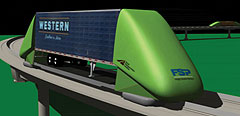- Is there a hidden cost to better fuel economy?
- Are there alternative approaches for paying for road construction and maintenance?
- What does congestion cost the typical Texas household?
- Are there other ways to move freight across the border?
The depth and breadth of Texas Transportation Institute’s expertise in all facets of transportation are valuable assets to lawmakers charged with addressing the state’s growing transportation needs. TTI has responded to an unprecedented number of information requests from individual lawmakers, legislative committees, the lieutenant governor and the speaker of the House. Here’s a sampling.
Is there a hidden cost to better fuel economy?

Yes — and it’s growing, according to TTI Research Scientist David Ellis. In testimony provided to the joint committee meeting of the Senate Finance Committee and the Senate Transportation and Homeland Security Committee last May, Ellis outlined the impact of key transportation finance variables including fuel efficiency, fuel consumption, debt service and vehicle registration fees. In the short term, better vehicle fuel efficiency is generating less revenue from the fuel tax at a time when road construction and maintenance costs are rising. In the long run, electric vehicles will generate no fuel tax revenue at all to cover the costs of the roads on which they drive. The two committees sought input from Ellis regarding the effect of Texas’ population growth on vehicle miles traveled, projected fuel efficiencies and construction commodity prices.
Are there alternative approaches for paying for road construction and maintenance?

As vehicles move away from traditional fuels to energy sources like electricity, the importance of identifying new ways to finance our transportation infrastructure grows. That effort is well underway at TTI.
TTI Senior Research Engineer Ginger Goodin and Associate Transportation Researcher Trey Baker testified before the Subcommittee on Funding of the House Select Committee on Transportation Funding last October on one possible exploratory study of using vehicle mileage fees (VMFs) in Texas. A similar briefing was held for legislative staffers prior to the current session.
Moving toward an actual ‘user fee’ for roadways represents a significant change over the current funding system, which taxes fuel purchases as a proxy for road use. The VMF study gathered input and perspectives from Texans, as well as engaged a panel of technology experts to outline possible deployment options for such a fee. Public concerns the researchers encountered included privacy issues, administrative costs and questions about enforcement.
What does congestion cost the typical Texas household?
The costs of congestion are evident at the pump since more time spent idling during rush hour burns more fuel.
In October, Ellis and TTI Research Engineer Tim Lomax appeared before the Select Committee on Transportation Funding of the Texas House of Representatives to assess congestion costs to Texas households under six different scenarios:

- current funding trend;
- increasing vehicle registration fees by $30;
- doubling vehicle registration fees;
- spending $4 billion annually on new construction and $2 billion annually on maintenance;
- using Texas Emissions Reduction Plan funds to offset bond and
- pass-through debt and using oil severance-tax revenues to recapture bond and pass-through debt.
The researchers plotted two variables for each of the six scenarios:
- the impact of congestion on common consumer commodity prices; and
- the cost, in terms of both extra travel time and extra fuel, of not addressing congestion.
Two trends emerged from this analysis:
- By 2035, the annual cost of congestion for Texas households, on average, will increase from the current $1,500 to almost $5,400.
- If congestion costs were kept at current levels, every $1 in transportation infrastructure improvements would produce an estimated $6 in economic benefit.
The researchers found that the $4 billion-per-year construction investment would likely result in saving the typical household $3,390 per year by 2035, while costing each household only $350.
Are there other ways to move freight across the border?
In a presentation to the Senate Committee on International Relations and Trade May 4, 2010, TTI Assistant Agency Director Steve Roop reported on the potential of a private-sector freight shuttle system to greatly improve border freight movement. The Freight Shuttle combines technology and operational strategies to provide sustainable and productive freight transportation. It’s designed to address critical freight transportation challenges, including:

- increasing predictability in freight movement;
- improving productivity, measured in terms of the relationship between cost and capacity;
- reducing infrastructure deterioration by removing vehicles from public roadways;
- improving air quality and
- providing greater security, improved safety and better risk management.
Using the best features of truck and rail freight movement, the freight shuttle system is an automated, non-stop, non-divertible means of moving both containerized and trailer-based goods, Roop noted.
